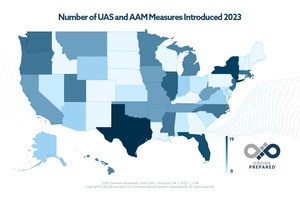Commercial drone operations are already providing essential services to the American public, and hold immense promise to simultaneously provide even more workforce, economic and environmental benefits as they expand to serve more communities.
As a part of our Drone Prepared initiative, the Association for Uncrewed Vehicle Systems International (AUVSI) tracked all legislation regarding drones and Advanced Air Mobility (AAM) introduced during this year’s state legislative sessions.
We found that 2023 was an incredibly active year, with Texas, New York, and Florida the most engaged states on these topics. Nationwide, nearly 200 measures were introduced from January to June, when most states are in session.
Recurring topics included operations over critical infrastructure, preventing contraband delivery, use by law enforcement and first responders, and study committees. Country of origin bans and AAM infrastructure also stood out as two emerging areas of interest this year.
As they address these issues and more – and to prepare states to harness the benefits of the growing drone industry – AUVSI recommends that state and local lawmakers adhere to four principles.
First, lawmakers should look for opportunities to promote drone use for public benefit by ensuring that relevant programs can be applied to drones and incorporating them into government activities.
The 2023 session saw several states proactively introducing measures that promote the use of emerging technologies, encourage state agency use, and create and fund pilot programs or other drone programs.
Budgets passed in Arizona, Florida, Kansas, Michigan, North Dakota, Texas, and Washington provide funding for the purchase of drones by state agencies, state drone programs, or the development of drone and AAM infrastructure. Other examples include bills like Florida HB 1264 to allow Departments of Agriculture to use drones to eradicate plant or animal diseases.
These measures position state agencies as leaders in leveraging drones to provide public benefit and preparing their state for intentional integration of AAM into their transportation planning.
Second, state and local lawmakers should leave air navigation and aviation safety to the Federal Aviation Administration (FAA). Federal authority over the airspace is a bedrock principal of aviation law in the U.S. and is one of the reasons why we enjoy the safest airspace in the world.
Federal preemption prevents a patchwork of conflicting state laws that would erode safety, divide the airspace, and hinder operations. It also provides certainty for industry, which reduces apprehension about expanding into new geographic service areas or market verticals.
Released in July, FAA’s Updated UAS Fact Sheet (2023) on State and Local Regulation of Unmanned Aircraft Systems resolutely establishes the FAA as the sole regulator of the airspace, no matter the altitude. While a truth is already established, the updated restatement upholds preemption at low level airspace. This is important for state lawmakers because it means that, before considering new legislation to regulate the use of drones, they should first examine if the proposed regulations are preempted.
Third, legislators should leverage existing law to address actions involving drones. Relying on existing statutes can streamline regulations and prevent the need for new legislation.
One area where this stood out in the 2023 sessions included measures to restrict drone flights around critical infrastructure and correctional facilities, with 19 measures introduced in ten states. The result is often the creation of “no-fly zones,” hindering legitimate commercial drone operations.
Another ongoing area of concern we tracked was trespass and privacy, with twelve measures introduced in eleven states to restrict flight over private property. These bills are harmful for drone operators as a form of airspace restriction and a violation of federal airspace laws.
While concerns are valid, these issues are largely already addressed in state statutes. Almost all states already have laws banning trespass, voyeurism, or the delivery of contraband – and these laws are no less applicable to drones. For example, Wyoming passed SF 32 this year, which prohibits the use of drones to deliver items to a correctional facility. However, under Wyoming Statute 6-5-213, the delivery of contraband is already prohibited, making the measure unnecessary.
The FAA UAS Fact Sheet further supports our recommendation, stating that: “Many of these state and local concerns are already addressed by laws that regulate ground-based conduct not involving UAS and such laws often can be applied to UAS.”
AUVSI’s final recommendation is that lawmakers exercise caution when regulating drone activity beyond what already exists in state code. The industry is rapidly evolving and expanding, and it is important that legislative language is not overly specific as to block innovation or become outdated.
To avoid hasty regulations that could have unintended consequences, legislators should take the time to gather the input of industry and the public. Ultimately, lawmakers should consider whether their actions will support economic investment, job creation, and increased access to communities.
For example, this year in Missouri a measure was introduced that would prohibit flight over private property within a 400-foot vertical distance. As this is the airspace in which drones operate, the measure, in addition to being federally preempted, was paramount to a prohibition on drone flight. Fortunately, the bill’s sponsors listened to industry concerns and accepted suggestions on the problematic language, removing the overflight provision and adding a commercial exemption – ultimately producing that did not ground the commercial drone industry.
By following these pillars of good governance with respect to UAS, lawmakers from around the country can ensure that their state or city is ready for the future of advanced aviation and the numerous benefits that drones, and eventually AAM, will bring to their communities.
Author: Scott Shtofman
Senior Manager of Government Affairs,
Association for Uncrewed Vehicles Systems
International (AUVSI)
www.auvsi.org
Printed in the 2023 Issue of UAS Magazine
 Unmanned Aerial Vehicle The latest drone news
Unmanned Aerial Vehicle The latest drone news






